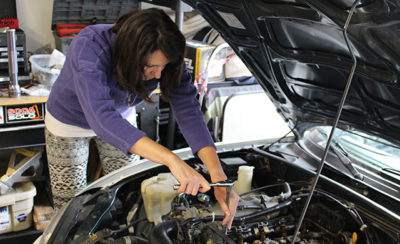Be ready to tackle your own race car maintenance at home
Some racers are fortunate enough to have the space to build or rent a proper race shop or the resources to hire a team to handle all the prep for them. But, in many cases that’s not feasible, so pre-race prep work needs to be done in the home garage by the racers. MazdaMotorsports.com spoke to some pros about the best practices racers can use at home.
“It might seem like a daunting task, but I wouldn’t get too nervous or anxious about [prepping a race car out of a home garage] because when we’re at the racetrack, we don’t have the comforts of a full shop,” says Winding Road Racing mechanic Brian Falcon. “We have what we bring in our trailer. We have to do gearbox swaps on our back on the ground when we need to, so if you have to do the same thing in your garage, it’s not that bad of a task.
“Some things can be a little bit cumbersome,” he admits. “Be patient, and if you need help, ask for help … don’t hurt yourself trying to manhandle a transmission out all by yourself.”
In order to do a transmission swap or basic pre-race prep in your garage, it’s helpful to have the right space to work in and the right tools to work with. Mark Nichols is the owner of Iron Canyon Motorsports, a car builder and prep shop in Southern California. Nichols recently downsized his business, moving from a shop to his garage at home to help eliminate a lot of overhead.
“First and foremost, you need an area that’s got good lighting and is clean and has enough work area to get around the car efficiently without having to move stuff in and out to clear space to get to your work areas,” he says. “Good lighting is very important; it’s important to be able to see underneath the car, so anything you can do to easily get the car into the air and get good light under the car is very helpful.”
Nichols suggests creating room underneath the car might even include installing a two-post lift, which can be relatively inexpensive and doesn’t take a lot of room. Other than that, something like a Bendpak QuickJack is more efficient than a jack and jack stands to work on brakes and do inspections. Besides a way to get the car off the tires and high enough to get under, and the basic tools you need to work on the car, there are a few other things to consider.
“Some of the most important tools I have in my shop are good battery-powered tools,” Nichols says. “Small impact guns, small electric screwdrivers like a Milwaukee 12-volt system, and a good half-inch impact wrench that keeps me from having to turn on the air compressor and make a lot of noise. In a small house or residential environment, the noise can be an issue, so if you can avoid using air and use electric tools instead, that’s very helpful.”
With the right environment and correct tools in place, what is the proper procedure for pre-race prep?
“Put eyeballs on everything in your drivetrain – motor mounts, diff mounts, all the various seals, and then nut-and-bolt your car,” says Falcon. “That’s huge. Before the race and every single night at the track our cars go up on the stands and we put wrenches on almost every bolt on the car and ensure that it’s tight, so that none of our drivers will have a failure that will lead to a DNF or something worse. Make sure you go over your car with a fine-tooth comb and just keep up on your maintenance. Swap out your fluids regularly, and look at the fluid that’s coming out, because that could give you some warning signs that you’re about to lose a component.”
In the near future, MazdaMotorsports.com will talk to others who perform their prep work in their home garages to find out what works best for them.


 ACCESSIBILITY
ACCESSIBILITY